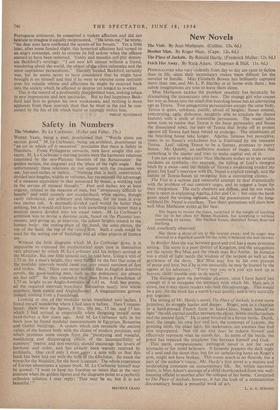Safety in Numbers
The Modulor. By Lc Corbusier. (Faber and Faber. 25s.)
WHERE Yeats, being a poet, proclaimed that "Words alone are certain good," M. Le Corbusier, being an architect, practitioner in "an art in which all is measured," proclaims that there is Safety in Numbers. From Pythagoras onwards, men have sought this cer- tainty. M. Le Corbusier's starting-points were the harmonic relations canonised by the neo-Platonic theorists of the Renaissance: the golden section, the diagonal and the 'place of the right angle.' But unfortunately these relations do not square with the measures we use, feet-and-inches or metric. "Nothing that is built, constructed, divided into lengths, widths or volumes, has yet enjoyed the advantage of a measure equivalent to that possessed by music, a working tool in the service of musical thought." Feet and inches are at least organic, related to the measure of man, but "atrociously difficult to handle" and until recently not standardised, while metres, though easily calculated, are arbitrary and inhuman, for no man .is ever two metres tall. A decimally-divided yard would be better than nothing, but it would still leave us with something little better than a musical octave divided into ten equal tones. M. Le Corbusier's ambition was to devise a diatonic scale, based on the Platonic har- monies, and giving us, as intervals, the salient heights related to the human body: the resting-place of the hand, the solar. plexus, the top of the head, the top of the raised 'arm. Such a scale could be used for the setting out of buildings and all other objects of human use.
Without the little diagrams which M. Le Corbusier gives, it is impossible to expound the mathematical steps (not in themselves very abstruse) by which M.'Le Corbusier and his helpers arrived at the Modulor. But one little episode can be told here. Using a unit of 1.75 in. for a man's height, they were baffled by the fact that none of the modular intervals would come out into round numbers of feet and inches. But, "Have you never noticed that in English detective novels, the good-looking men, such as the policemen, are always six feet tall?" So they expanded their man from a Frenchman of 1.75 m. height to an Anglo-American of 1.83 m. And, hey presto, all the required intervals translated themselves neatly into whole numbers, both metric and Anglo-Saxonl A magnanimous gesture indeed, coming from a Frenchman.
Looking at one of the modular series translated into inches, I found myself wondering where I had seen it before. Then remem- bered: there were the figures, 8 ins., 10i ins., 13 ins. and 17 ins. which I had arrived at empirically when designing myself some bookshelves a few years ago. And M. Le Corbusier tolls in his book how he found modular measurements in Egyptian, I3yzantine and Gothic buildings. A system which can reconcile the ancient values of the human body with the claims of modern precision, and which promises some escape from the "paralysing and wasteful, maddening and discouraging effects of the incompatibility of numbers" (metric and non-metric), should encourage the lovers of harmony and order, and has already been warmly received by architects. One cavil only 1 must ,cater: a note tells us that this book has been laid out with the heIP-61 the 'Modulor. So much the worse for the Modulor, for the book is square. The whole experience of Europe abominates a square book. M. Le Corbusier himself may be quoted : "I want to keep my freedom so intact that at the very moment when the golden figures and the diagrams point to a perfectly orthodox solution I may reply: 'That may be so, but it is not beautiful.'
MAURICE CRAIG


















































 Previous page
Previous page